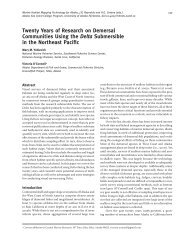724_Final Report.pdf - North Pacific Research Board
724_Final Report.pdf - North Pacific Research Board
724_Final Report.pdf - North Pacific Research Board
Create successful ePaper yourself
Turn your PDF publications into a flip-book with our unique Google optimized e-Paper software.
CONCLUSIONS<br />
The results from this captive feeding study demonstrated that the greatest influence on the FA<br />
composition of eider adipose tissue is diet. For both species of eiders, changes in diet were discriminated<br />
using adipose tissue FAs. Captive eider diet items were reliably differentiated from each other using both<br />
multivariate DFA and more rigorous QFASA simulations. Our results also demonstrated that the response<br />
of adipose tissue FAs in both species of eiders to dietary intake was highly predictable. Relative dietary<br />
percentages of these five diet items were accurately quantified by QFASA when those percentages had<br />
been constant for 10 weeks. Three weeks after a shift between diets with very distinct FA profiles, the<br />
shift was clearly reflected in tissue FA but the estimated dietary percentages were lower from the true<br />
percentages in diet, reflecting an integration of previous diet in the estimations and confirming that<br />
turnover was not complete within the 21-29 d study periods. Most dietary subsets used in QFASA yielded<br />
very similar estimates of dietary percentages, although one subset appreciably underestimated the<br />
percentages of Mazuri feed and krill and overestimated the percentage for mussels. Comparison of results<br />
for a suite of dietary subsets should identify such problems. CCs for the two eider species fed a diet of<br />
88% Mazuri with supplements of krill, silversides, and bivalves were very similar and yielded similar<br />
results. When CCs for common murre chicks fed entirely Atlantic silversides were applied to eiders in<br />
this study, dietary estimates were similar except for slower loss of and more rapid incorporation of FA<br />
from silversides.<br />
Diet items were correctly classified with 80% - 100% accuracy in the DFA using only 14 out of<br />
the 72 FAs identified. The DFA demonstrated that multivariate techniques are an important precursor to<br />
using the QFASA model in determining which potential diet items have overlapping FA signatures. In the<br />
QFASA simulations, FA profiles of mussels and silversides also had the lowest rate of discrimination<br />
from other diet items in the prey library, but were still well identified at a rate of 93% to 98%. The eider<br />
biopsies were correctly classified with 97.9% accuracy using only 7 out of the 72 FAs identified in the<br />
DFA and showed that there were changes in FA signatures among biopsies and therefore that they<br />
reflected changes in diet, which was confirmed later in the QFASA model.<br />
Model estimates were strongly influenced by the FA subset and CC set. The Reduced A and B<br />
FA subsets were modified from the published Dietary FA subset and provided the best overall diet<br />
estimates for spectacled and Steller’s eiders, respectively (Table 2, Fig. 5 in Chapter 1). The Extended<br />
Dietary subset and subsets modified from it provided poorer diet estimates. FAs were omitted from the<br />
published subsets in order of highest variability observed in CCs, which tended to provide better diet<br />
estimates. In contrast, Iverson et al. (2007) removed FAs with large CCs, which produced poorer<br />
estimates in the model. However, diets, CCs and bird species differed between studies and likely<br />
42



